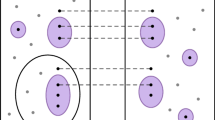Abstract
Can theorem proving in mathematical logic be addressed by classical mathematical techniques like the calculus of variations? The answer is surprisingly in the affirmative, and this approach has yielded rich dividends from the dual perspective of better understanding of the mathematical structure of deduction and in improving the efficiency of algorithms for deductive reasoning. Most of these results have been for the case of propositional and probabilistic logics. In the case of predicate logic, there have been successes in adapting mathematical programming schemes to realize new algorithms for theorem proving using partial instantiation techniques. A structural understanding of mathematical programming embeddings of predicate logic would require tools from topology because of the need to deal with infinite-dimensional embeddings. This paper describes the first steps in this direction. General compactness theorems are proved for the embeddings, and some specialized results are obtained in the case of Horn logic.
Similar content being viewed by others
References
Andersen, K. A. and Hooker, J. N.: A linear programming framework for logics of uncertainty, Manuscript, Mathematical Institute, Århus University, 8000 Århus C,Denmark, 1992.
Araque, G. J. R. and Chandru, V.: Some facets of satisfiability, Technical Report CC-91-13, Institute for Interdisciplinary Engineering Studies, Purdue University, West Lafayette, IN 47907, USA, 1991.
Blair, C., Jeroslow, R. G. and Lowe, J. K.: Some results and experiments in programming techniques for propositional logic, Comput. Oper. Res. 13 (1988), 633–645.
Borkar, V. S., Chandru, V. and Mitter, S. K.: A linear programming model of first order logic, Technical Report IISc-CSA-95-5, Indian Institute of Science, 1995.
Chandru, V. and Hooker, J. N.: Extended horn sets in propositional logic, J. ACM 38(1) (1991), 205–221.
Chandru, V. and Hooker, J. N.: Optimization Methods for Logical Inference, Wiley-Interscience, 1999.
Conforti, M. and Cornuéjols, G.: A class of logical inference problems soluble by linear programming, J. ACM 33 (1994), 670–675.
Gallo, G. and Rago, G.: A hypergraph approach to logical inference for datalog formulae, working paper, Dip. di Informatica, University of Pisa, Italy, September 1990.
Hooker, J. N.: A mathematical programming model for probabilistic logic, working paper 05-88-89, Graduate School of Industrial Administration, Carnegie Mellon University, Pittsburgh, PA 15213, July 1988.
Hooker, J. N.: Input proofs and rank one cutting planes, ORSA J. Comput. 1 (1989), 137–145.
Hooker, J. N.: New methods for computing inferences in first order logic, Ann. Oper. Res. (1993), 479–492.
Jaffar, J. and Lassez, J.-L.: Constraint logic programming, Technical Report 86/73, Department of Computer Science, Monash University, 1986.
Jaffar, J. and Lassez, J.-L.: Constraint logic programming, in Proc. 14th Symposium on Principles of Programming Languages, Munich, Jan. 1987, pp. 111–119.
Jaffar, J. and Maher, M. J.: Constraint logic programming: A survey, J. Logic Programming 19/20 (1994), 503–581.
Jeroslow, R. G.: Computation-oriented reductions of predicate to propositional logic, Decision Support Systems 4 (1988), 183–197.
Jeroslow, R. G.: Logic-Based Decision Support: Mixed Integer Model Formulation, Ann. Discrete Math.40, North-Holland, Amsterdam, 1989.
Kagan, V., Nerode, A. and Subrahmanian, V. S.: Computing definite logic programs by partial instantiation and linear programming, Technical Report 93-15, Mathematical Sciences Institute, Cornell University, 1993.
Kavvadias, D. and Papadimitriou, C. H.: A linear programming approach to reasoning about probabilities, Ann. Math. Artificial Intelligence 1 (1990), 189–206.
Munkres, J. R.: Topology: A First Course, Prentice-Hall, 1975.
Nilsson, N. J.: Probabilistic logic, Artificial Intelligence 28 (1986), 71–87.
Rockafeller, R. T.: Convex Analysis, Princeton University Press, 1970.
Schrijver, A.: Theory of Linear and Integer Programming, Wiley, New York, 1986.
Schöning, U.: Logic for Computer Scientists, Birkhäuser, 1989.
Wang, J.-C. and VandeVate, J.: Question-asking strategies for Horn clause systems, Ann. Math. Artificial Intelligence 1 (1990).
Author information
Authors and Affiliations
Rights and permissions
About this article
Cite this article
Borkar, V.S., Chandru, V. & Mitter, S.K. Mathematical Programming Embeddings of Logic. Journal of Automated Reasoning 29, 91–106 (2002). https://doi.org/10.1023/A:1020521718123
Issue Date:
DOI: https://doi.org/10.1023/A:1020521718123




